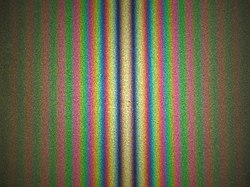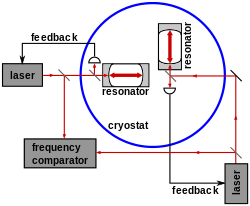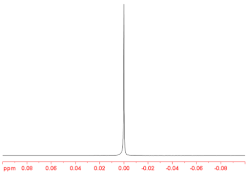Michelson–Morley experiment
The Michelson–Morley experiment was a scientific experiment to test for the presence and properties of a substance called aether. This was thought hypothetically to fill empty space. The experiment showed the substance did not exist.
The experiment was done by Albert A. Michelson and Edward Morley in 1887.[1]
Since waves in water need something to move in (water) and sound waves do as well (air), it was believed that light also needed something to move in.[2] Scientists in the 18th century named this substance "aether", after the Greek god of light. They believed that aether was all around us and that it also filled the vacuum of space. Michelson and Morley created this experiment to try and prove the theory that aether existed. They did this with a device called an interferometer. This experiment is a test of Einstein's special relativity theory.
The experiment

The Earth travels very quickly (more than 100,000 km per hour) around the Sun.[3] If aether exists, the Earth moving through it would cause a "wind" in the same way that there seems to be a wind outside a moving car. To a person in the car, the air outside the car would seem like a moving substance. In the same way, aether should seem like a moving substance to things on Earth.
The interferometer was designed to measure the speed and direction of the "aether wind" by measuring the difference between the speed of light traveling in different directions. It measured this difference by shining a beam of light into a mirror that was only partially coated in silver. Part of the beam would be reflected one way, and the rest would go the other. Those two parts would then be reflected back to where they were split apart, and recombined. By looking at interference patterns in the recombined beam of light, any changes in speed because of the aether wind could be seen.
They found that there was, in fact, no substantial difference in the measurements. This was puzzling to the scientific community at the time, and led to the creation of various new theories to explain the result. The most important was the Lorentz factor, which is used in Albert Einstein's special theory of relativity.
Michelson–Morley Experiment Media
Michelson and Morley's interferometric setup, mounted on a stone slab that floats in an annular trough of mercury
A depiction of the concept of the "aether wind"
Michelson's 1881 interferometer. Although ultimately it proved incapable of distinguishing between differing theories of aether-dragging, its construction provided important lessons for the design of Michelson and Morley's 1887 instrument.
Fringe pattern produced with a Michelson interferometer using white light. As configured here, the central fringe is white rather than black.
Expected differential phase shift between light traveling the longitudinal versus the transverse arms of the Michelson–Morley apparatus
Michelson–Morley experiment with cryogenic optical resonators of a form such as was used by Müller et al. (2003).
Other websites
| Wikimedia Commons has media related to Lua error in Module:Commons_link at line 62: attempt to index field 'wikibase' (a nil value).. |
References
- ↑ Michelson, Albert A.; Morley, Edward W. (1887). "On the Relative Motion of the Earth and the Luminiferous Ether". American Journal of Science. 34 (203): 333–345. Bibcode:1887AmJS...34..333M. doi:10.2475/ajs.s3-34.203.333. S2CID 124333204.
- ↑ "Electromagnetic nature of light".
{{cite journal}}: Cite journal requires|journal=(help) - ↑ "How fast is the earth moving?". Scientific American. Retrieved 18 January 2017.






